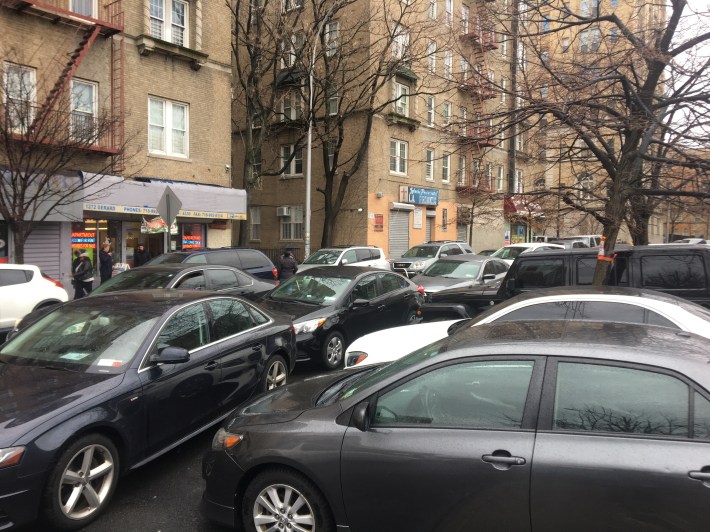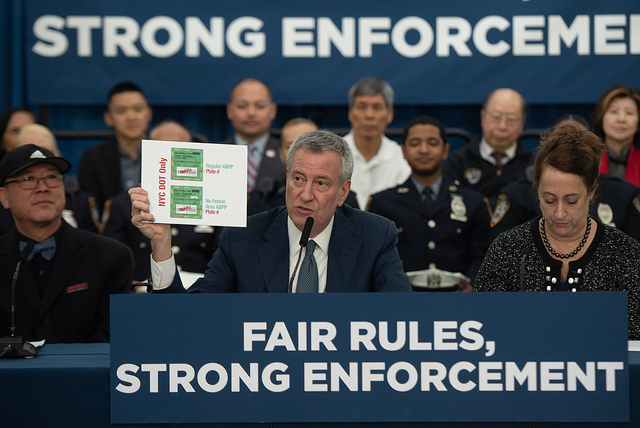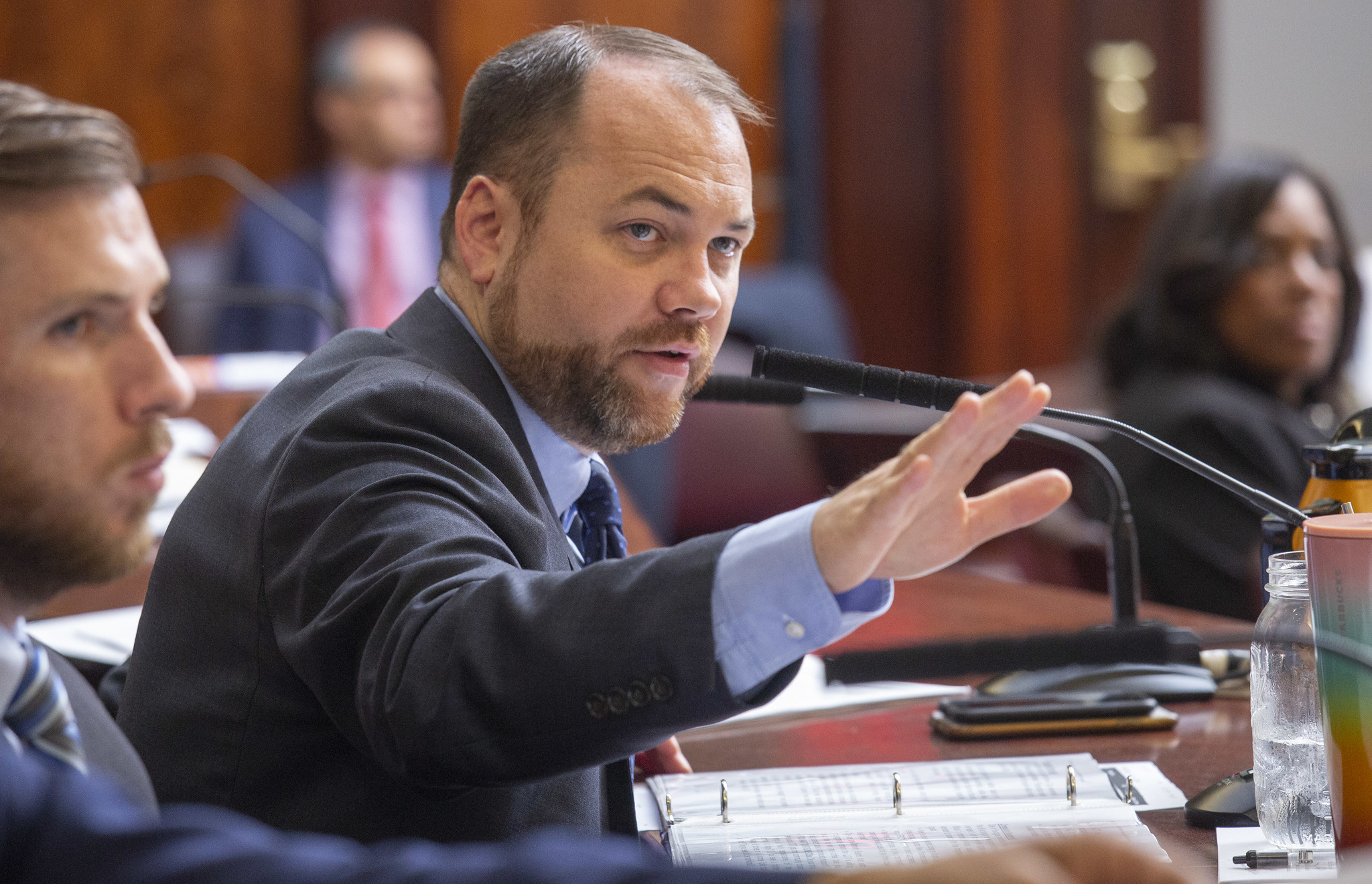Meet the new placard abuse crackdown — same as the old placard abuse crackdown?
City Council Speaker Corey Johnson vowed (albeit unconvincingly) on Tuesday that this will be the year that the city finally begins the year's long process of turning around years of false starts and empty previous promises and, yes, really starts to address the low-level corruption of city employees parking wherever they want merely by flashing a city-issued placard, or pretty much anything, on their dashboard to indicate some vague connection to city government.
If that sounds like a lot of hemming and hawing, ha ha, well, it is!
First, the facts: On Tuesday, the City Council passed a package of bills that Johnson says will finally put an end to something that's been illegal for years: public officials (or their adjacent friends) parking in front of fire hydrants, in crosswalks, in bike lanes and in bus lanes, and even on sidewalks.
This corruption, Johnson said, is the low-hanging fruit of street safety.
“We've been talking a lot about how to fix our streets lately but even good design doesn't work if people simply don't follow the law," Johnson said before the passage of the slate of legislation. "No driver has the right to take away space for pedestrians, cyclists, and bus drivers. We've tolerated it for years as one of those unchanged facts of life in New York City, but those days are hopefully over."
Next, the nine new bills:
- Intro 314 requires the NYPD to issue periodic reports on the improper use of city-issued parking permits. The reports would be due every six months, with the first due no later than June 2020. (This law addresses complaints that the NYPD does not provide information about how many officers it has busted for placard abuse, a number that is extremely low.)
- Intro 1394 makes it illegal for city vehicles to block a bike lane, bus lane, crosswalk, sidewalk, or fire hydrant. (Fact check: this is already illegal.)
- Intro 596 increases the fine for unauthorized or fraudulent city-issued parking permits from $250 to $500. (It is unclear how many people have ever been hit with even the $250 tickets.)
- Intro 927 requires the NYPD to create a centralized electronic tracking system for all city-issued parking permits; and requires NYPD to issue monthly reports to agencies whose employees have parking permits about any summonses received by those employees. (It is astounding that such a system does not already exist.)
- Intro 1393 requires NYPD traffic agents to conduct at least 50 “targeted enforcement sweeps” per week, monitored by the Department of Investigations and based on 311 complaints. (The Department of Investigation has been caught abusing placards.)
- Intro 1395 requires 311 to accept complaints and photographs related to illegal parking and the misuse of parking permits. (Streetsblog showed this spring why this will likely not change a thing.)
- Intro 932 establishes a three-strikes-and-you’re-out rule, revoking the placard if its recipient illegally parks three times; and revokes placards from those who have unpaid parking or traffic violations in excess of $350. (This is not a new promise. And besides, if the NYPD is issuing summonses, it is unlikely that any NYPD employee will ever get three tickets, given that officers tend to not write tickets against cars with NYPD placards, vests, log books or even PBA "get out of jail" cards on their dashboards.)
- Intro 942 requires each city agency that hands out parking permits to develop a plan for appropriate distribution. Individual plans would be due by Nov. 1, 2020, and a comprehensive city plan, which would include looking at reducing the number of city-issued placards, would be due a month later. (This promise sounds very familiar.)
- Intro 1422 creates a singular application process, and accountability, for parking permits, which, going forward, can only be issued the Department of Transportation, the NYPD, and the Department of Education. (It is unclear how this will eliminate placard abuse by state officials, court officers, Postal Service workers and the literally dozens of real, sort-of real and completely fake agencies whose employees park wherever they want.)

All of the bills seek to, in some small way, crack down on the essential problem of entitled city employees who have been given thin sheets of laminated paper that they believe allows them to park anywhere — and a city government that has done virtually nothing to dissuade them of this false notion. There are roughly 150,000 real placards in circulation, and many many more fake ones.
Why will this time be any different?
Mayor de Blasio has pledged in February to crack down on rampant placard abuse — reforms that advocates say didn't go far enough. That promise followed a previous 2017 promise to stop the problem.
But much of the difficulty with reining in illegal parking stems from those tasked with doing the enforcement. NYPD traffic agents are responsible for ticketing their fellow municipal employees and even other cops — and, as a result of the badge they wear, are notoriously bad at enforcing the law no matter what NYPD-logo-covered document is sitting on the dash (even an old Police Officer Exam with a barely passing grade).
But one of the nine new bills, introduced by Johnson, will put another agency — the Department of Investigation — in charge of making sure the NYPD is actually writing tickets. The NYPD would be required to take pictures of the offending car and document what action was taken, the speaker said.
“[Traffic enforcement agents] are supposed to be writing summonses and tickets for placard abuse, but they don’t always do it because they’re afraid of policing police — that is why we put in Department of Investigation as a check, an independent overseer," Johnson said.
But much of legislative package is the same-old promises — even Johnson admitted that actually stopping placard abuse means relying on agencies with a history of lax enforcement of the law to suddenly get strict. In other words, hey Fox, we've got a great henhouse for you to check out.
How is this different from what the mayor proposed in February?

The mayor's plan to crack down on placard abuse fell short of getting to the root of the problem — he did not put any additional oversight on the NYPD to do its job and refused to reduce the number of placards (instead, the mayor actually vowed to create more dedicated parking spots near police stationhouses or in expensive garages, so cops could continue to drive to work.
The Council's nine bills go a few steps further, but still include much of the same, including the three-strikes rule, and creating an electronic tracking system for all city-issued parking permits.
De Blasio's February reforms would have created a paltry 10-agent unit at the Department of Transportation to enforce illegal placard parking in known hotspots like Lower Manhattan and Downtown Brooklyn, but the council's requires the NYPD to conduct 50 targeted sweeps each week all over the city. (Transportation Alternatives has long called for this enforcement to be automated with machines that read license plates and can mail tickets directly to the owner of the car — a process that would eliminate the ability of NYPD employees looking the other way at NYPD scofflaws.)
Johnson said some of de Blasio's suggestions were commendable, but that the nine passed on Tuesday will really make a difference.
Why not just reduce the number of city-issued parking permits?
More than 150,000 placards are currently in circulation — up at least 50,000 since de Blasio took office. Hizzoner has been criticized repeatedly for not reducing or even capping placards. In short: de Blasio has ruled over chaos as bearers of placards, real or fake, are encouraged to drive because they know they can park wherever they want.
Walk around any police precinct or school in the city. Stroll the streets around out government buildings in Lower Manhattan, Downtown Brooklyn, and Jamaica, Queens. Or just hop on over to the @placardabuse Twitter account, where watchdogs have been documenting the problem for more than three years. Chaos.
The problem comes down to enforcement, or lack thereof. In the hands of the NYPD, it’s often non-existent.
Simply put: Cops don’t write tickets against other cops. And they’re loath to write tickets against fellow government workers — in part for fear of retaliation for ticketing a superior. Case-in-point: In 2004, DOT traffic agent Barbara Soto-Centeno was suspended for two weeks without pay after giving a parking summons to then-NYPD Transportation Chief Michael Scagnelli, the very man responsible for the police department’s traffic enforcement efforts.
“It’s notoriously difficult to enforce,” Brooklyn-based parking guru Rachel Weinberger told Streetsblog earlier this year. “The alignment is wrong. You’re enforcing a crime that you’re committing.”
Politicians have been loathe to question the perk because — checks notes — they're some of the biggest offenders. In 2017, for example, Brooklyn Assembly Member Diana Richardson parked illegally outside of her office on Empire Boulevard district office, and summons-shamed the traffic agent by posting her name on Facebook. (The post was eventually deleted.) Later that year, then-State Senator Marty Golden, a former NYPD cop, flashed his parking placard and threatened to arrest a cyclist his driver was tailgating in a bike lane. More recently, State Senator Kevin Parker told a GOP senate staffer to kill herself after she identified his car illegally parked in a bike lane. Employees in state Attorney General Letitia James and Brooklyn Borough President Eric Adams' offices are the big stars on the Placard Abuse Twitter feed.
Johnson admitted his package of bills doesn't reduce the number of placards, but one bill, introduced by Queens Council Member Peter Koo, does require the city to review all placards. "If there are too many and come back and formulate a plan to reduce them," Johnson said. (If?!)
Sure, the package fails to immediately address the excessive number of placards in use — but advocates said that the legislation should be judged by its enemy: the NYPD opposed every single one of the bills. So maybe, just maybe, the have some bite after all.
"Despite a few shortcomings this is a tremendously positive step in the right direction," said Marco Conner, co-deputy director of Transportation Alternatives. "[The fact that] NYPD opposed the entire package of bills [is] a strong indication that this is actually moving in the right direction."






